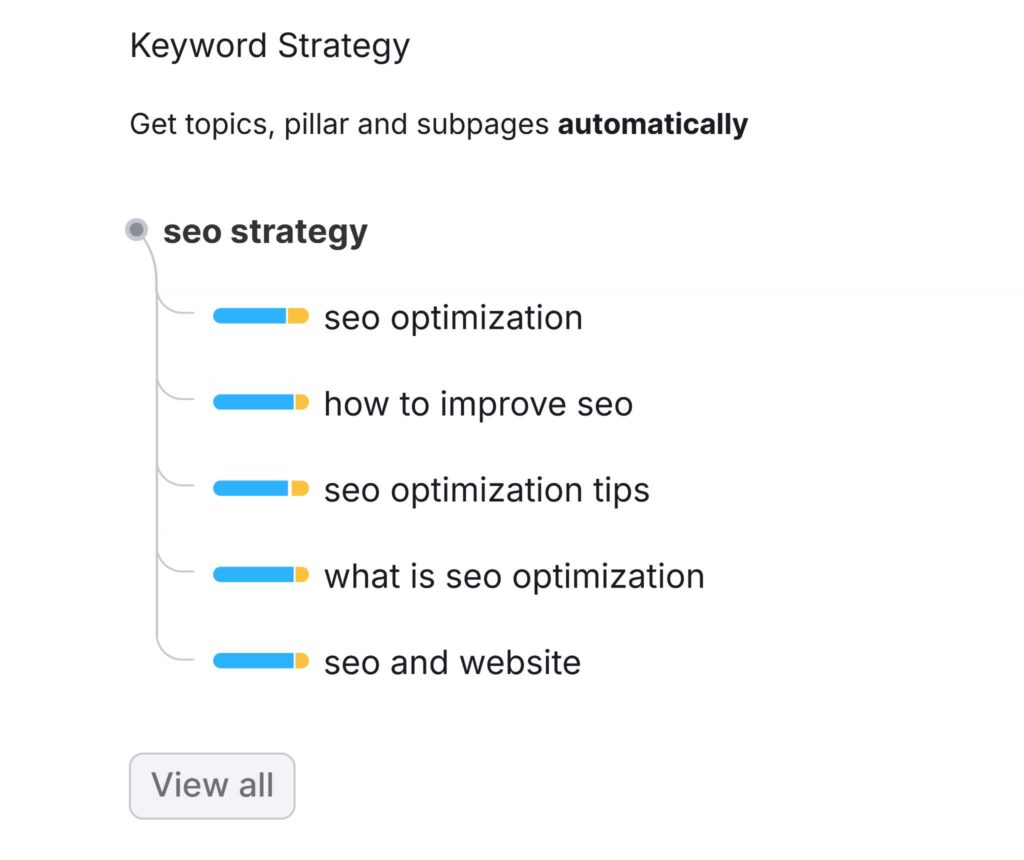Content clusters have revolutionized how we approach SEO strategy, making it easier to organize content in a way that search engines and users love. Instead of creating disconnected blog posts, this model helps you build topic authority through strategically linked content pieces. Ready to dive into this game-changing approach? Let’s walk through exactly how to build content clusters that actually rank and drive meaningful traffic.
Map your core topics first
Creating effective content clusters starts with identifying your core topics. These form the foundation of your entire strategy, so let’s make sure you’re starting on solid ground.
List key pillars tied to your goals
Begin by aligning your content pillars with your business objectives. What are you trying to accomplish? If you’re a digital marketing agency, your pillars might include SEO, content marketing, social media, and PPC. For an eco-friendly clothing brand, pillars could be sustainable materials, ethical manufacturing, capsule wardrobes, and care techniques.
- Review your business goals and identify 4-8 broad topics that directly support them
- Check search volume for these topic areas to confirm audience interest
- Validate with your sales team to ensure the topics address common customer questions
The key is selecting pillars broad enough to spawn multiple subtopics but specific enough to establish real expertise. Your content cluster strategy will fail if your pillars don’t connect directly to what your business actually does.
Pick SEO topics your brand can lead
Not all topics are created equal when it comes to your chances of ranking. The best content clusters focus on areas where your brand has genuine expertise and can provide unique value.
Ask yourself: What topics can we genuinely be authoritative about? What unique insights, data, or approaches can we offer that competitors can’t? This might mean focusing on niche areas rather than the broadest, most competitive topics.
For example, instead of targeting “social media marketing” (extremely competitive), a boutique agency might focus on “social media for local restaurants” or “Instagram marketing for professional services.” These narrower topic clusters give you a fighting chance to establish dominance.
Group keywords under each SEO pillar
Once you’ve identified your pillar topics, it’s time to build out the supporting keyword clusters. Each pillar should have dozens of related subtopics that users are actively searching for.
| Pillar Topic | Sample Cluster Keywords |
|---|---|
| Content Clusters | Content cluster examples, topic cluster templates, pillar page structure, internal linking for SEO |
| Email Marketing | Email subject line formulas, email automation workflows, segmentation strategies, email deliverability tips |
Use keyword research tools to uncover related terms, questions, and phrases. Look for patterns in search intent – are people looking for guides, comparisons, or specific solutions? Group similar keywords that could be addressed in a single piece of content to avoid keyword cannibalization.
Build a topic cluster model
With your core topics and keywords mapped out, it’s time to organize them into a strategic topic cluster model that search engines can understand.
Connect cluster pages using internal links
The magic of the content cluster model happens through intentional internal linking. This isn’t random linking – it’s a deliberate structure that signals relationships between content.
Your pillar page should link to all related cluster content, and each cluster page should link back to the pillar. This creates a clear topical relevance signal to search engines and helps distribute link equity throughout your cluster.
Some best practices for internal linking in your content clusters:
- Use descriptive anchor text that includes keywords when appropriate
- Ensure links are contextual and helpful to users, not forced
- Create a hub-and-spoke visual in your content planning to track linking relationships
- Add links to new cluster content as it’s published
Cover all major intents in content cluster

A comprehensive content cluster addresses all the ways users might search for information on your topic. This means covering different search intents:
- Informational – Users seeking knowledge or answers (how-to guides, explanations)
- Navigational – Users looking for specific resources or websites
- Commercial – Users researching before making a purchase decision (comparisons, reviews)
- Transactional – Users ready to take action (buy, download, sign up)
By covering the full spectrum of intents, your topic cluster becomes the complete resource for that subject, increasing your chances of capturing traffic at every stage of the customer journey.
Align pillar and clusters to search journey
Think about how people actually search for information on your topic. They typically start with broad questions and gradually get more specific as they learn. Your content cluster should mirror this natural progression.
Your pillar content can address broader concepts while cluster content drills down into specifics. For example, if your pillar is “Content Cluster Strategy,” your clusters might include step-by-step guides for keyword research, templates for planning clusters, and case studies showing results.
Map your content to different stages of awareness:
- Problem awareness: Content that helps users identify their challenges
- Solution awareness: Content that educates about possible approaches
- Product awareness: Content that showcases your specific solutions
Create high-performing pillar content
Your pillar content is the cornerstone of your cluster. It needs to be comprehensive, authoritative, and user-friendly.
Structure SEO pillar pages with scannable data
Pillar pages are typically longer and more comprehensive than standard blog posts. To keep readers engaged, structure them for easy scanning:
- Use clear heading hierarchy (H2s, H3s, H4s)
- Include a clickable table of contents at the top
- Break up text with bullets, numbered lists, and tables
- Add visual elements like diagrams, charts, or infographics
- Use bold text to highlight key points
Include data points, statistics, and research findings to enhance credibility. Make these elements stand out visually so readers can quickly extract valuable insights.
Add internal links to topic clusters
Your pillar page should serve as a comprehensive introduction to the topic while strategically linking to deeper dives in your cluster content.
When adding these internal links:
- Place links where they add genuine value, not just for SEO purposes
- Use descriptive anchor text that clearly indicates what the linked content offers
- Consider adding a “related resources” section that collects all cluster content in one place
- Ensure all links are working properly and direct to the intended content
Update pillar pages regularly for freshness
Search engines prefer fresh, accurate content. Set a calendar reminder to review and update your pillar pages quarterly. When updating:
- Add links to new cluster content you’ve published
- Update statistics, examples, and references
- Expand sections based on new developments in your industry
- Review user comments and questions to identify gaps to address
- Check for broken links or outdated information
Each update signals to search engines that your content remains relevant and authoritative, potentially boosting your rankings over time.
Conclusion
Building a successful content cluster strategy isn’t a one-time project but an ongoing commitment to creating connected, comprehensive content. Start by mapping your core topics based on business goals, build out your topic cluster model with strategic internal linking, and create pillar content that serves as a valuable resource hub. As you continue to expand your clusters with fresh content, you’ll build topical authority that signals to both users and search engines that you’re a trusted source in your niche. The beauty of this approach is that it scales with your business, allowing you to continuously strengthen your SEO foundation while providing genuine value to your audience.
FAQs
How many pages go into one content cluster?
There’s no magic number, but most effective content clusters contain 8-20 pages. The exact count depends on your topic’s breadth and depth. Start with a pillar page and 5-7 core cluster pages covering main subtopics, then expand based on keyword research and audience needs. Quality always beats quantity – each piece should serve a distinct purpose and address specific search intents.
Can content clusters boost traffic quickly?
Content clusters typically deliver results over the medium to long term rather than immediately. You might see initial traffic increases within 3-6 months as search engines recognize your internal linking structure, but the full SEO benefits often take 6-12 months to materialize. The good news? Once established, clusters tend to maintain and even grow their traffic over time, unlike many short-lived SEO tactics.
Do content clusters work for all industries?
Yes, but implementation varies by industry. Content clusters work particularly well for complex topics where users need multiple pieces of information before making decisions. B2B companies with longer sales cycles often see excellent results. Even in more straightforward B2C industries, clusters can be effective by focusing on the questions and concerns specific to your audience. The key is adapting the model to your audience’s unique search behaviors.
What’s the ideal length for SEO pillar pages?
Pillar pages typically range from 2,000-5,000 words, but there’s no strict rule. Focus on comprehensively covering your topic while maintaining quality and engagement. Remember that user experience matters more than word count – a well-structured 2,500-word pillar page that answers key questions will outperform a rambling 5,000-word page that loses readers. Use the topic’s complexity and competitive landscape as your guide.
How do topic clusters affect search rankings?
Topic clusters improve search rankings in several ways. First, they demonstrate topical authority by showing depth and breadth of expertise. Second, the internal linking structure helps distribute link equity throughout your site. Third, clusters naturally address related keywords and search intents, expanding your ranking opportunities. Finally, the user-friendly organization often improves engagement metrics like time on page and reduced bounce rates, which search engines interpret as quality signals.

Ridam Khare is an SEO strategist with 7+ years of experience specializing in AI-driven content creation. He helps businesses scale high-quality blogs that rank, engage, and convert.



